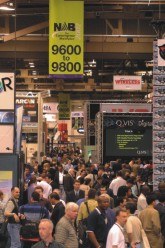|

Inside
the magazine
Self-help message board
Article reprints
How to contact us
Web links directory
Software downloads
Tips and advice
Fire-wire campaign
Subscribe today
Help Me, I'm new!
Fair pricing petition
Home

In
Software Downloads:
Adobe
Premiere 6 (trial)
Paint Shop Pro 7 (trial)
Tips
and Advice:
How to get started with
computer video editing
Fire-wire
Campaign:
Join our ongoing campaign
|
NAB2002 Review
 Having
barely recovered from the blisters acquired trailing the halls at NAB2001,
Ian Wadkins arrived in Las Vegas to discover that, this year, the biggest
broadcast exhibition in the world just got bigger - by almost one million
square feet. Having
barely recovered from the blisters acquired trailing the halls at NAB2001,
Ian Wadkins arrived in Las Vegas to discover that, this year, the biggest
broadcast exhibition in the world just got bigger - by almost one million
square feet.
New DV camcorders
were being displayed by Sony and JVC. Sony's DSR-PDX10 will see its
consumer release in the form of the TRV-950, a replacement for the popular
TRV-900 model. The US list price of $2,900 will buy a camcorder with
three CCDs, 12x optical zoom and Memory Stick slot. A 128MByte Memory
Stick is said to record up to 85 minutes of MPEG-1 video.
Multi-format functionality was also in evidence with JVC's Streamcorder,
first seen at last year's IBC exhibition when it had the rather more
mundane name of GY-DV300. The name change is a reflection of the new
market that JVC sees for the product, thanks to the addition of the
KA-DV300 network pack. This attaches to the base of what is already
a very capable three-CCD DV camcorder and enables it to output real-time
MPEG-4 video streams through a wireless network for live internet broadcasts.
JVC also includes software for desktop control of up to four Streamcorders,
enabling the user to operate the camera controls, view all outputs simultaneously
and switch between them for sophisticated low-cost live internet productions.
The system is available for shipping immediately, with a list price
for the entire package of $4,300, with the camcorder available on its
own for $3,495.
Panasonic was showing two new MiniDV products, the DV1DC portable field
recorder and the DVX100 camcorder. The DV1DC is looking to challenge
Sony's dominance in portable MiniDV decks and is an ultra compact unit
complete with a fold-out 3.5 inch colour screen that makes it look not
unlike a camcorder with its lens and viewfinder removed - which, essentially,
it is. It's slated for early summer release at US$1,495. Even with a
direct dollar to pound conversion, which seldom happens, it may be too
expensive to worry Sony.
Film quality
Prior to NAB, Panasonic had announced preliminary information about
the DVX100 camcorder, a tactic that drew many visitors to the stand.
What got folks' interest was the fact that the DVX100 is the first affordable
camcorder to offer 24 frames per second progressive scan capture - known
as 24p - to achieve a closer approximation to the look of film, although
how close was difficult to evaluate with the non-functioning mock-up
on show!
Even aside from the appeal of 24p, the DVX100 is a very well specified
unit, with full manual control including focus, iris and zoom functions
of its Leica lens, as well as XLR microphone inputs with phantom power.
Its list price of $3,500 isn't unreasonable, so we expect it to be a
popular alternative to the Sony VX-2000 and Canon XL-1 when released
at the end of the summer. The DVX100 does not have native 16:9 support,
however, which seems odd when the unit is targeted at digital cinematography.
For those seeking to emulate the look of film without investing in a
new camcorder, Digieffects announced an overhaul of its CineLook plug-in
package for Adobe After Effects. CineLook2 offers a range of enhancements,
including specific support for PAL footage, and a re-vamped user interface.
Digieffects has also responded to the biggest complaint about the original
- very long render times - claiming that CineLook2 is up to 100 times
faster than its predecessor. The bad news is that what was already a
fairly expensive add-on will also see a price hike to $895 when the
new version arrives in the summer.
Software enhancements
Over at Canopus's stand, the company's decision to use software Codecs
rather than hardware versions was bearing fruit. The DVStorm editing
system works faster on faster PCs, and a new free downloadable software
update promised for June should speed up rendering on all machines,
and - on powerful PCs - support up to five simultaneous streams of video,
complete with the usual real-time processing of filters and transitions
on each stream. Quite what specs are required wasn't made clear.
Canopus was also showing an impressive new transcoding package, ProCoder,
available in June at a list price of $699. This allows the conversion
of source video files into multiple output formats simultaneously, with
support for all popular formats including MPEG-1, MPEG-2, DV, Windows
Media, Real Video and QuickTime - even DivX. A neat feature is its ability
to take files of different formats and combine them into a single output
format, complete with basic editing facilities and filters. The program
runs speedily and will provide competition for Discreet's Cleaner 5
range.
Matrox was again pushing the envelope of the RT2000/2500 system's effects
capabilities with the announcement of a free update for the Pro-Pack
add-on giving a host of new transitions and filters, including ripples
and mesh warps. The company was also showing InfonetTV, an interesting
new hardware/software combination designed to enable the easy creation
and distribution of programming for traditional or internet broadcasting.
Matrox provides hundreds of ready-made templates that look to allow
even novice users to simply and quickly combine video, stills and text
into professional looking 'television channels' on a single PC. The
addition of a web module allows the creation of an identical interactive
version of the output channel for simultaneous internet broadcast.
 Its primary
target market is for community and cable television channels - an application
that may well soon become more relevant in this country. Its primary
target market is for community and cable television channels - an application
that may well soon become more relevant in this country.
Datavideo were displaying two useful products scheduled for an early
June release, the DV Bank and DV Repeater. The DV Bank is a hard-disk-based
video deck, complete with front panel transport controls and RS422 external
control. It's available in 60GByte and 100GByte configurations offering
4.5 and 7.5 hours record time. Video input and output is via FireWire,
although the addition of a bi-directional analogue/DV converter, such
as Datavideo's own DAC-2, would enable analogue sources to be connected.
The DV Bank can also be optionally powered by a battery pack for field
recording. It has numerous applications, such as event videographers
looking for extended recording times, but we'd like to see it rather
less expensive than the expected $1,100 list price. The DV Repeater,
though, is priced at $85 and is a device that enables numerous FireWire
devices to be connected to Windows or Mac computers.
At last year's NAB, the halls were awash with products aimed at exploiting
the new potential offered by broadband internet connections, and at
that time we did feel that perhaps many of the companies would struggle
to survive in waiting for a revenue-generating reality. Sadly, judging
by the absence of many of these companies at NAB2002, this looks to
have been the case. But internet broadcasting has enjoyed some interesting
developments. Microsoft was offering a preview of its latest Windows
Media technology, codenamed Corona, which promises major advances in
the speed of delivery and quality of streaming media.
Using what Microsoft calls Fast Stream, broadband users are able to
have instant play of streaming media, which will eliminate the annoying
delays caused by buffering data prior to playback. From a quality point
of view, the demo we saw was approaching HDTV standard, and complete
with 5.1 surround sound audio. Microsoft says that this sort of performance
can be achieved with data rates approximately half those for DVD Video.
RealVideo 9
Similar advances were also being talked about by another major player
in streaming media, Real Networks. The new RealVideo 9 and RealAudio
Surround formats are targeting broadband and dial-up users, with a new
RealOne player offering similar instant start capabilities to Microsoft's
Corona. Over 20 companies are already using RealVideo 9 to deliver content,
complete with the sort of interactivity that makes internet broadcasting
such an exciting proposition. Real and Microsoft each hopes that its
new technologies, combined with the growing number of broadband connections,
can finally deliver the sort of TV-style experience that can translate
this exciting possibility into a viable reality.
If the sort of quality on display from both companies can make the leap
from the controlled environment of a corporate demo to appearing at
an ISP near you, then we might well look back on the next 12 months
as the year when internet broadcasting finally did take off. It may
still be a little optimistic to say that you'll be watching NAB2003
from your desktop instead of reading about it in Computer Video,
so we'd better start looking for some more comfortable shoes.
|
Recent features...
View
The Archive
Reviewed in June's issue:
NAB 2002
Apple Final Cut Pro 3
Apple iMac with SuperDrive
Pioneer DVR-7000
In June's news:
Photoshop supports OS X
The end for tape?
DVD burning for Vaios
Iomega external HDDs
ADS 2.5in FireWire drive bay
Pinnacle DV500
Roxio WinOnCD
CD Creator DVD support
|





 Having
barely recovered from the blisters acquired trailing the halls at NAB2001,
Ian Wadkins arrived in Las Vegas to discover that, this year, the biggest
broadcast exhibition in the world just got bigger - by almost one million
square feet.
Having
barely recovered from the blisters acquired trailing the halls at NAB2001,
Ian Wadkins arrived in Las Vegas to discover that, this year, the biggest
broadcast exhibition in the world just got bigger - by almost one million
square feet. Its primary
target market is for community and cable television channels - an application
that may well soon become more relevant in this country.
Its primary
target market is for community and cable television channels - an application
that may well soon become more relevant in this country.